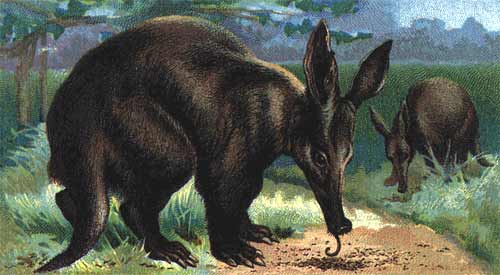|

Chew on This: The most distinctive charactristic of aardvarks is their teeth. Instead of having a pulp cavities, aardvark teeth have lots of thin tubes of dentine, each containing pulp and held
together by cementum. The teeth have no enamel coating and are worn
away and regrow continuously. In adults, the only teeth are the molars at
the back of the jaw.

Appearance: The Aardvark is only vaguely pig-like; the body is stout with an
arched back; the limbs are of moderate length. The ears are disproportionately
long and the tail very thick at the base with a gradual taper. The
greatly elongated head is set on a short, thick neck, and at the
end of the snout is a disk in which the nostrils open. The mouth
is typical of species that feed on termites: small and tubular.
The Aardvark has a long, thin, protrusible tongue and elaborate
structures supporting a keen sense of smell. The Aardvark is a pale yellowish gray in color, often
stained reddish-brown by soil. The coat is thin and the animal's
primary protection is its tough skin; the Aardvark has been known
to sleep in a recently excavated ant nest, so well does it protect
them.

Aardvark of Africa: The Aardvark is distributed across most of sub-Saharan Africa, and although killed by humans both for its flesh and for its teeth (which are used as decorations), does not appear to be threatened.
Insects for Dinner: The Aardvark is nocturnal and a solitary creature that feeds almost
exclusively on ants and termites. An Aardvark emerges from its burrow
in the late afternoon or shortly after sunset, and forages over
a considerable home range, swinging its long nose from side to side
to pick up the scent of food. When a concentration of ants or  termites
is found, the Aardvark digs into it with its powerful front legs,
keeping its long ears upright to listen for predators, and takes
up an astonishing number of insects with its long, sticky tongue—as
many as 50,000 in one night has been recorded. It is an exceptionally
fast digger, but otherwise moves rather slowly. termites
is found, the Aardvark digs into it with its powerful front legs,
keeping its long ears upright to listen for predators, and takes
up an astonishing number of insects with its long, sticky tongue—as
many as 50,000 in one night has been recorded. It is an exceptionally
fast digger, but otherwise moves rather slowly.
Burrow Park: Aside from digging out ants and termites, the Aardvark also excavates
burrows to live in: temporary sites scattered around the home range
as refuges, and the main burrow which is used for breeding.
Burrow Basics: Main
burrows can be deep and extensive, have several entrances, and can
be as much as 13 meters long. The Aardvark changes the layout of
its home burrow regularly, and from time to time moves on and makes
a new one. Only mothers and young share burrows.
Trivia:
* Aardvark is usually considered the first noun in the English dictionary.
* Arthur Read is a fictional aardvark (despite looking more like a mouse) with human-like traits. He is a book and television character created by Marc Brown.* Cerebus the Aardvark is a comic aardvark created by Canadian artist Dave Sim.
* Jason Webley, the musician, has a song about an aardvark.
* The Raccoons, a popular Canadian animated television show in the late 1980's, featured a pink, anti-environmentalist aardvark named Cyril Snear.
* Earlham College (Richmond, Indiana) is the only American liberal arts university, outside of zoological institutes, with a comprehensive concentration in the study of aardvarks.
* In the Pink Panther cartoon there was a character named the "Blue Aardvark". The Pink Panther represented innocence and un-fortune, The Blue Aardvark was unkind and ill-polite...

After a gestation period of 7 months, a single cub weighing around
2 kg is born, and is able to leave the burrow to accompany its mother
after only two weeks. At six months of age it is digging its own
burrows, but it will often remain with the mother until the next
mating season. The Aardvarks can grow older than 20 years in captivity.
 The Aardvark is the only surviving member of the family Orycteropodidae and of the order Tubulidentata. The Aardvark was originally placed in the same genus as the South American anteaters because of superficial similarities which, it is now known, are the result of convergent evolution, not common ancestry. For the same reason, Aardvarks bear a striking first-glance resemblance to the marsupial bilbies and Bandicoots of Australasia, which are not placental mammals at all. The Aardvark is now placed in its own genus, Orycteropus. The Aardvark is the only surviving member of the family Orycteropodidae and of the order Tubulidentata. The Aardvark was originally placed in the same genus as the South American anteaters because of superficial similarities which, it is now known, are the result of convergent evolution, not common ancestry. For the same reason, Aardvarks bear a striking first-glance resemblance to the marsupial bilbies and Bandicoots of Australasia, which are not placental mammals at all. The Aardvark is now placed in its own genus, Orycteropus.

All text is available under the terms
of the GNU Free Documentation License
|
